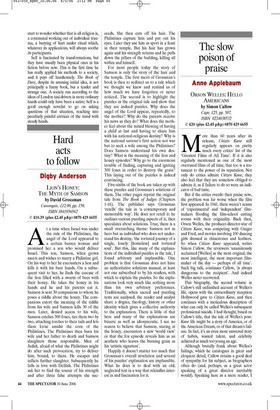Hard acts to follow
Digby Anderson
LION’S HONEY: THE MYTH OF SAMSON by David Grossman Canongate, £12.99, pp. 159, ISBN 1841956562 ✆ £10.39 (plus £2.45 p&p) 0870 429 6655 At a time when Israel was under the rule of the Philistines, the angel of the Lord appeared to a certain barren woman and promised her a son who would deliver Israel. This son, Samson, when grown meets and wishes to marry a Philistine girl. On his way to her he encounters a lion and kills it with his bare hands. On a subsequent visit to her, he finds the carcase of the lion filled with a swarm of bees with their honey. He takes the honey in his hands and he and his parents eat it. Samson is sent 30 companions to whom he poses a riddle about the honey. The companions extort the meaning of the riddle from his wife and Samson kills 30 of the men. Later, denied access to his wife, Samson catches 300 foxes, ties them two by two, attaching torches to their tails and lets them loose amidst the corn of the Philistines. The Philistines then burn his wife and her father to death and Samson slaughters those responsible. Men of Judah, afraid of what the Philistines might do after such provocation, try to deliver him, bound, to them. He escapes and inflicts further slaughter. Subsequently he falls in love with Delilah. The Philistines ask her to find the source of his strength and after three false attempts she suc ceeds. She then cuts off his hair. The Philistines capture him and put out his eyes. Later they use him as sport in a feast in their temple. But his hair has grown again and his strength returns and he pulls down the pillars of the building, killing all within and himself.
For most people today the story of Samson is only the story of the hair and the temple. The first merit of Grossman’s book is then to redirect us to a tale which we thought we knew and remind us of how much we have forgotten or never noticed. The second is to highlight the puzzles in the original tale and show that they are indeed puzzles. Why does the angel of the Lord appear, repeatedly, to the mother? Why do the parents receive his news as they do? What does the mother feel about the mixed blessing of having a child at last and having to share him with his national-religious destiny? Why is the national saviour’s first action not war but to seek a wife among the Philistines? Does Samson understand his own destiny? What is the meaning of the lion and honey episodes? Why go to the enormous trouble of finding, capturing and igniting 300 foxes in order to destroy the grain? This laying out of the puzzles is indeed convincing.
Five-sixths of the book are taken up with these puzzles and Grossman’s solutions of them. The other pages reprint the original tale from The Book of Judges (Chapters 1-16). The publisher says Grossman ‘retells’ the tale in ‘a contemporary and memorable way’. He does not retell it: he outlines various puzzling aspects of it, then speculates about solutions. True, there is a small overarching theme: Samson not as hero but as individual who does not understand his destiny, ‘the tortured journey of a single, lonely [homeless] and tortured soul’. But this, like many of the explanations of the individual puzzles in the tale, I found arbitrary and implausible. One problem is that Grossman does not have an authoritative solutions manual, at least not one subscribed to by his readers, with which to explain the puzzles. So the explanations look very much like nothing more than his own arbitrary preferences. Traditionally, when sacred and puzzling texts are analysed, the reader and analyst share a dogma, theology, history or other identity which gives a collective authority to the explanation. There is little of that here and many of the explanations are bizarre as well as idiosyncratic. I see no reason to believe that Samson, staring at the honey, encounters a new ‘world view’ or that the fox episode reveals him as an aesthete who leaves the burning grain as his ‘artistic signature’.
Happily it doesn’t matter too much that Grossman’s overall revelation and several of his puzzles’ explanation are implausible. What he does is to deal with an old, neglected text in a way that rekindles interest in and fascination for it.


















































































 Previous page
Previous page